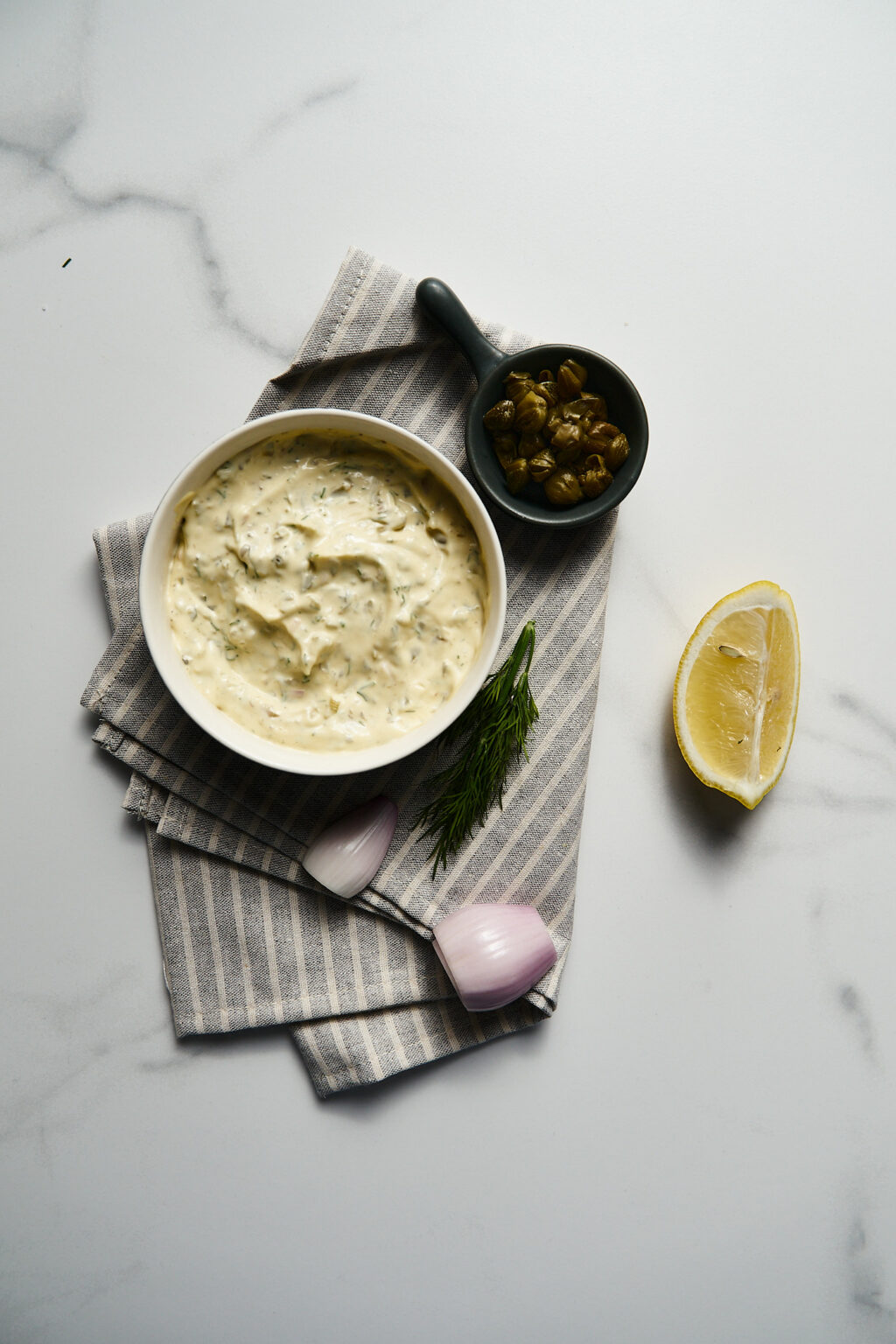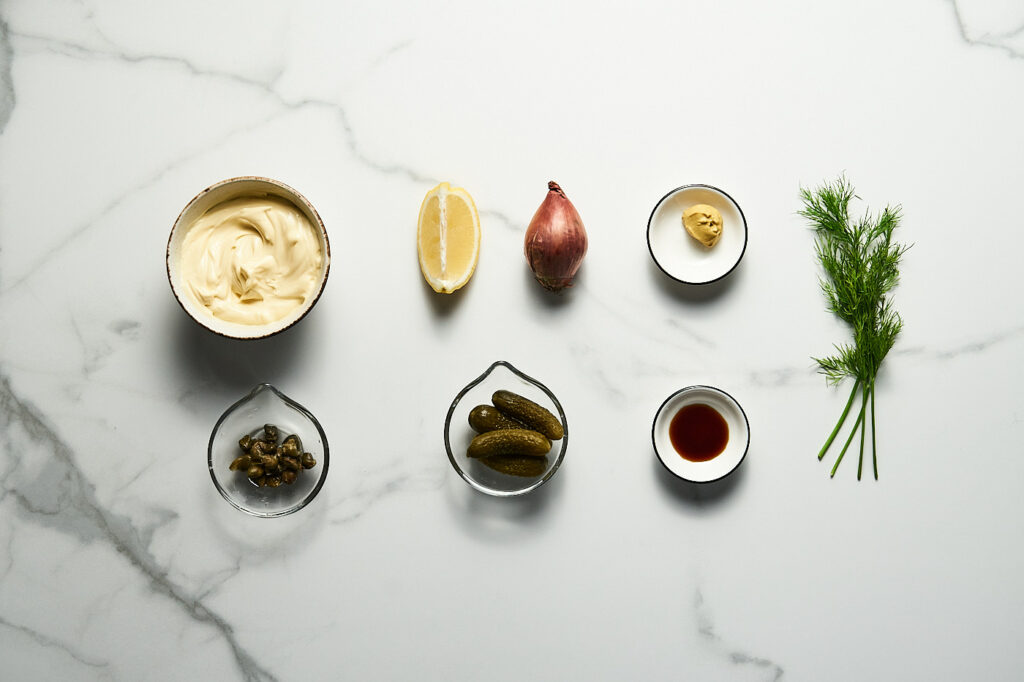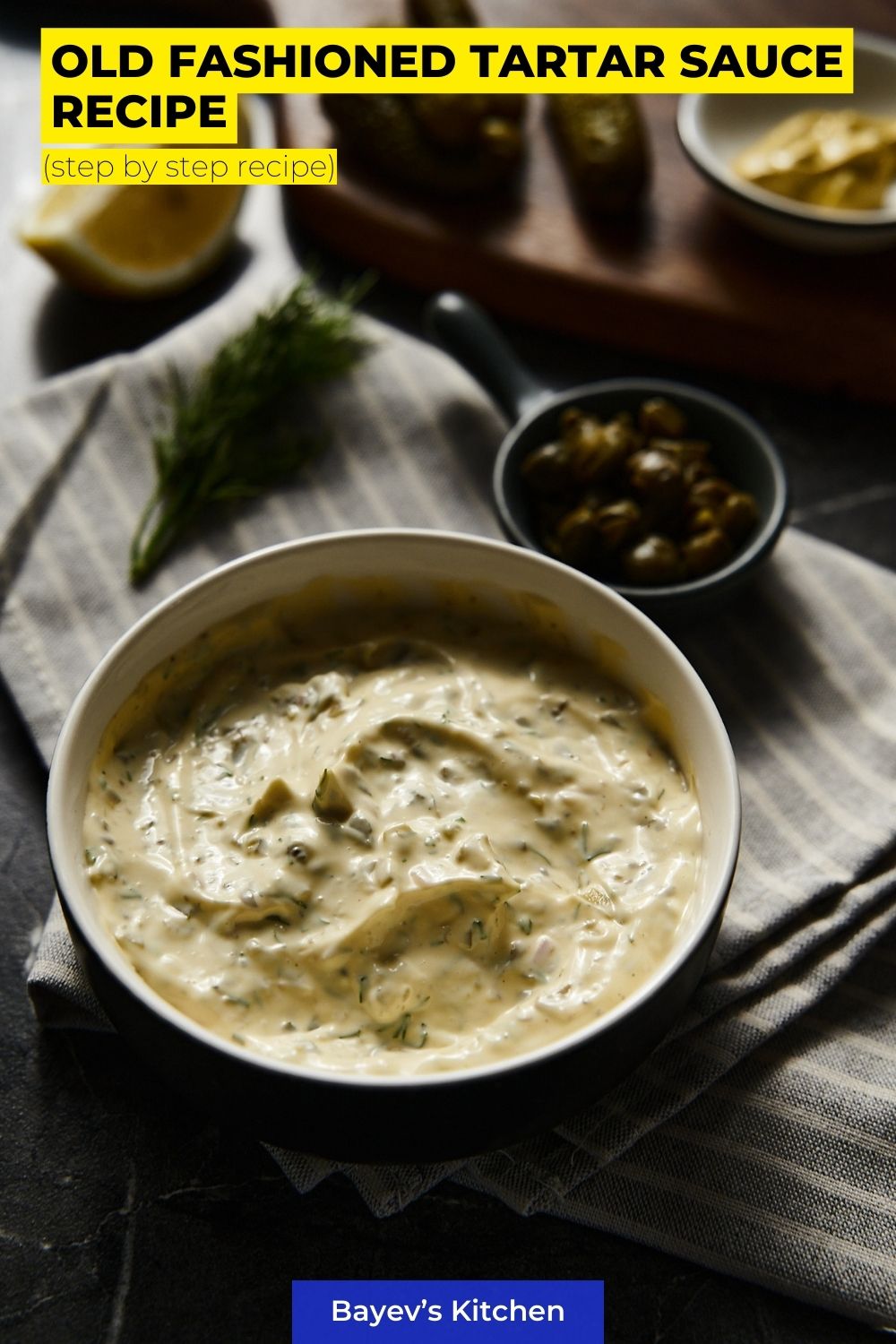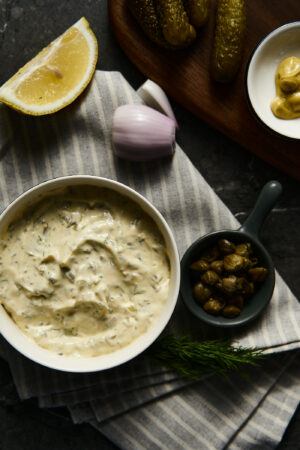It is believed that tartar sauce, as we know it today, originated in France. The name probably comes from the Tatars, a nomadic group from Central Asia, although the sauce itself is not related to their culinary traditions. This connection seems more like a culinary myth, lending an exotic aura to the sauce.
Over time, tartar sauce began to be made differently in various regions, with unique ingredients added according to local tastes.
But our recipe today takes us back to the classic, old-fashioned version – a proven combination of ingredients that has stood the test of time.
This version of tartar sauce includes capers, marinated cucumbers, dill, shallots, Worcestershire sauce, Dijon mustard, black pepper, and lemon juice, all mixed with mayonnaise. Each of these ingredients plays a key role in creating a distinctive flavor profile.
Capers and marinated cucumbers give a sharp tang, balancing the creaminess of the mayonnaise. Worcestershire sauce and Dijon mustard provide a spicy depth and a slight heat, while dill brings a fresh herbal note. Finally, lemon juice adds a bright acidity.
Although tartar may seem straightforward, its preparation requires attention to balance. Too much of any one ingredient can overpower the others. Therefore, I recommend preparing a slightly larger amount of ingredients, add according to the recipe, and then fine-tune the taste — adding the remaining as needed.
I must also stress that tartar becomes more flavorful after it has had some time to sit. This is necessary for the flavors to meld together. So I recommend preparing it in advance, letting it rest in the refrigerator for at least 30 minutes, and then, adding more pickles/onions/lemon to perfect the taste.
Tartar pairs beautifully with seafood dishes that are fried or grilled, as its acidity and tanginess balance the rich, fatty flavor. It is also a classic component of fish and chips, but its versatility allows it to be used anywhere from sandwiches and burgers to Chinese-style fried shrimp.
Given its origin and most common use, tartar sauce can be considered part of both French and English cuisine, although it is also often found in American dishes.
Contents

⏱ Cooking time — 40 minutes overall. Includes 10 minutes of preparation and cooking + 30 minutes unattended.
🔪 Ingredients
Per ~300 g of sauce:
- 200 g (7 oz) of mayonnaise (ideally self-made or high-quality store made, I use Hellmann’s)
- 13 g (1 tbsp.) capers
- 50 g (1 ¾ oz) marinated cucumbers/pickles (~3-4 small pcs.)
- 3 to 4 small sprigs of dill
- ¼ shallot
- ½ tsp. Worcester sauce
- ½ tsp. dijon mustard
- black pepper
- ⅛ large lemon (juice only)

🥣 Directions
Dill and Shallot Preparation
Take 3-4 small sprigs of dill. Separate the leaves from the stems, gently plucking them off with your hands or cutting the stems with a knife. Discard the stems and finely chop the leaves with a knife.
Take a shallot, cut it in half and peel it. Dice half of the onion into small cubes.
Marinated cucumbers and Capers Preparation
Cut 50 g (1 ¾ oz) of marinated cucumbers into small cubes. To do this, first slice the pickles into thin slices, making vertical cuts. Then cut the slices into thin strips (julienne), gather all the sliced pickles together, rotate the strips 90°, laying the long side towards you, and dice them into small cubes.
Finely chop 13 g (1 tbsp.) of capers.
Mix the chopped capers and pickles together. Continue to chop them with a knife until they are minced. In my opinion, the finer, the better.
Mixing and Seasoning the Sauce
Take 200 g (7 oz) of mayonnaise. Add to it half of the chopped onion (about ¼ of the onion), dill and about ¾ of the chopped pickles. Mix all the ingredients together well.
Add ½ tsp. of Worcestershire sauce and ½ tsp. of Dijon mustard. Squeeze the juice from ⅛ of a large lemon (I take a quarter of a lemon and squeeze out about half by eye).
Again, mix all the ingredients well and add freshly ground black pepper, to taste.
Cover the sauce with cling film and put it in the fridge for at least 30 minutes for the flavors to blend.
Final Taste Test and Serving
Before serving, take the sauce out of the fridge. Taste and, if needed, add the remaining pickles, shallots or more lemon juice, and salt. Adjust according to your taste. Stir before serving.
Serve with your favorite fried fish, seafood, or other dishes.
Store leftovers in the fridge and use within 5-7 days to maintain the best taste and freshness.
🧊 How to Store
Like any other sauce, tartar sauce can go bad. Factors that may contribute to this include how it’s stored, whether it’s homemade or store-bought, and the freshness of the ingredients used.
Homemade tartar sauce, like the one in this recipe, should be kept in the refrigerator and is usually best when used within 5-7 days. If your tartar sauce develops an off smell, changes color, or shows visible signs of mold, it’s best to discard it.
Store-bought tartar sauce usually has a longer shelf life due to the preservatives used, but it should also be refrigerated after opening and used by the ‘best by’ date on the packaging. Even so, it’s still good to check for signs of spoilage such as changes in color, texture, or smell before using it.
Refrigerating:
- Transfer the cooled tartar sauce into a clean, airtight container.
- Refrigerate immediately.
- Tartar sauce should last for 5-7 days in the refrigerator.
Freezing:
Freezing tartar sauce is not recommended. The mayonnaise in the sauce will not freeze well and can separate, losing its creamy texture upon thawing.
In all cases, the signs that the tartar sauce has gone bad are the presence of mold, an off smell, or a change in color or texture. If you notice any of these signs, discard the sauce immediately.
🥗 What to serve with?
- Battered Fried Fish. This is a classic combination, deeply rooted in the traditional fish and chips dish of British cuisine. The crispy, slightly oily batter of the fish contrasts beautifully with the tangy, creamy tartar sauce, creating a balanced taste sensation.
- Grilled Shrimp Skewers. The charred, slightly smoky flavor of grilled shrimp is excellently counterbalanced by the cool, acidic tartar sauce. The capers and pickles within the sauce also add an extra layer of complexity to this pairing, making it a gastronomic delight. The sauce would also go great with pan-fried prawns.
- Steamed Mussels. The natural brininess of the mussels harmonizes well with the tartar sauce, and the creaminess of the sauce adds a rich mouthfeel that enhances the overall eating experience.
- Roasted Vegetables. If you’re looking for a vegetarian option, roasted vegetables such as zucchini, bell peppers, or eggplant would work well. The earthy, slightly sweet flavors of the vegetables are nicely contrasted by the tartar sauce’s acidity and spice.
- Potato Wedges or French Fries. Potatoes, with their starchy, slightly sweet flavor, make an excellent counterpart to the sharp, complex tartar sauce. Whether you choose thicker wedges or thin, crispy fries, the combination is undeniably comforting and satisfying.
The beauty of tartar sauce lies in its versatility. It’s not only a condiment for seafood; it can transform a wide range of dishes, both non-vegetarian and vegetarian, into a culinary delight. The key is finding a combination that balances the creamy, tangy, and slightly spicy sauce with other flavors, creating an enjoyable and well-rounded dining experience.
🙋♂️ FAQ
Can I substitute any other herb for dill?
Dill is a classic ingredient in tartar sauce, but if you don’t have it on hand, you can try substituting it with fresh parsley or tarragon. Keep in mind, the flavor profile will be slightly different.
Why should the sauce sit in the refrigerator before serving?
Letting the sauce sit in the refrigerator for at least 30 minutes allows the flavors to meld together, making it more flavorful.
How finely should I chop the capers and pickles?
It’s a matter of personal preference, but the finer they are chopped, the more evenly they can be distributed throughout the sauce, creating a smoother texture.
Can I make a vegan version of this tartar sauce?
Yes, you can substitute the mayonnaise with a vegan mayo to create a vegan version of this tartar sauce.
How long can I store the leftover tartar sauce?
Leftover tartar sauce can be stored in the refrigerator and used within 5-7 days to maintain the best taste and freshness.
Can I adjust the recipe to my taste?
Absolutely. Feel free to adjust the amounts of pickles, shallots, lemon juice, and salt according to your personal taste.
I don’t have Worcestershire sauce. Can I still make this tartar sauce?
Yes, you can still make tartar sauce without Worcestershire sauce. The sauce will lack some depth of flavor, but it will still be tasty. You might want to add a bit more mustard or lemon juice to compensate.
Can I use a different type of onion if I don’t have shallots?
Yes, you can substitute shallots with red onion or white onion, but the flavor may be slightly different. Shallots are generally milder and more delicate in flavor.
What kind of mayonnaise should I use for the recipe?
You can use any type of mayonnaise that you prefer. Some people prefer using homemade mayonnaise for a fresher flavor, but store-bought mayonnaise works just as well.
I’m not a fan of capers. Can I omit them from the recipe?
Yes, you can leave out the capers if you prefer, but they do add a distinctive tangy and briny flavor to the sauce that balances the creaminess of the mayonnaise.
How do I know if my tartar sauce has gone bad?
If your tartar sauce has an off smell, change in color, or visible mold, it’s best to discard it.
Can I freeze leftover tartar sauce for later use?
It’s not recommended to freeze tartar sauce as it can separate and lose its creamy consistency when thawed.

Old Fashioned Tartar Sauce Recipe

Ingredients
- 200 g mayonnaise (ideally self-made or high quality store made, I use Hellmann's
- 13 g capers (1 tbsp.)
- 50 g marinated cucumbers/pickles (~3-4 small pcs.)
- 3-4 small sprigs of dill
- ¼ shallot
- ½ tsp. Worcester sauce
- ½ tsp. dijon mustard
- black pepper
- ⅛ large lemon (juice only)
Instructions
- Finely chop the dill and shallot.
- Dice the marinated cucumbers and capers into small cubes and mix them together, continuing to chop until they are chopped.
- Add half of the chopped onions, dill and most of the chopped cucumbers to the mayonnaise. Mix all ingredients well. Add the Worcester sauce, Dijon mustard and lemon juice. Once again, mix all ingredients well, add black pepper to taste and leave in the refrigerator for 30 minutes.
- Taste the sauce before serving and add the remaining cucumbers, shallot or more lemon juice if necessary, and salt. Stir before serving.
